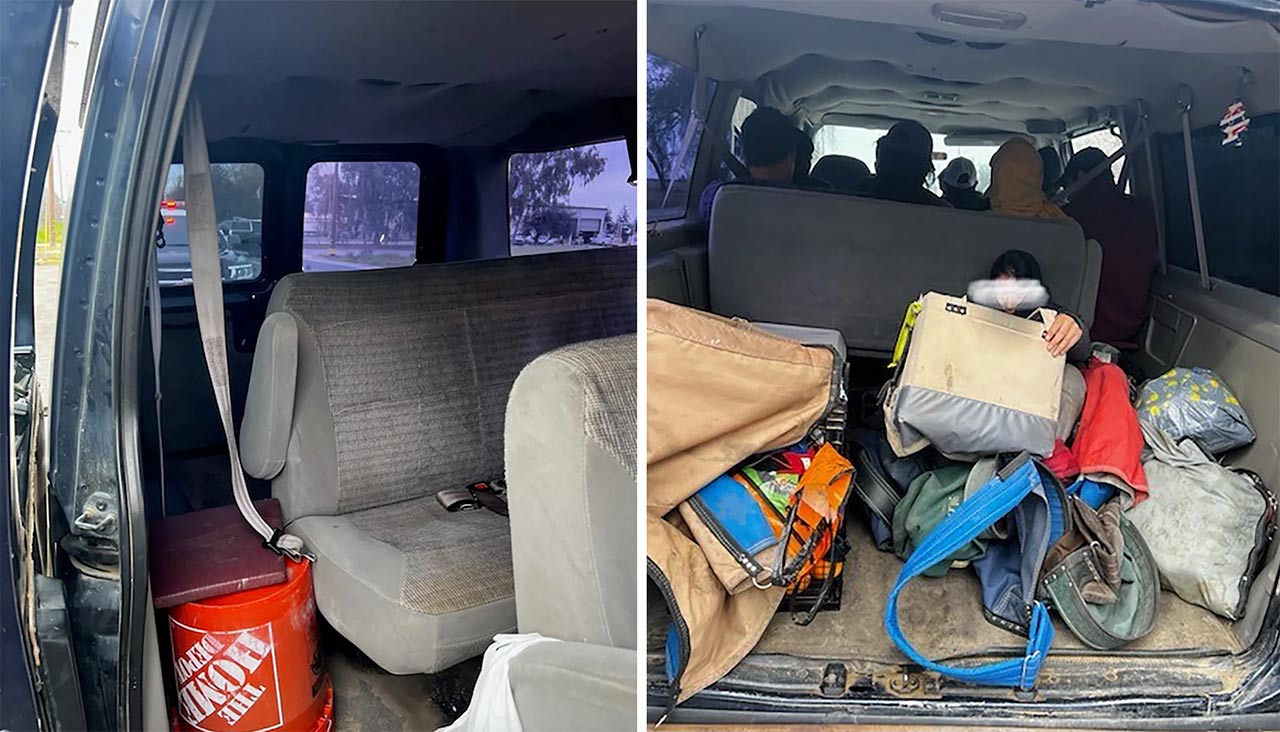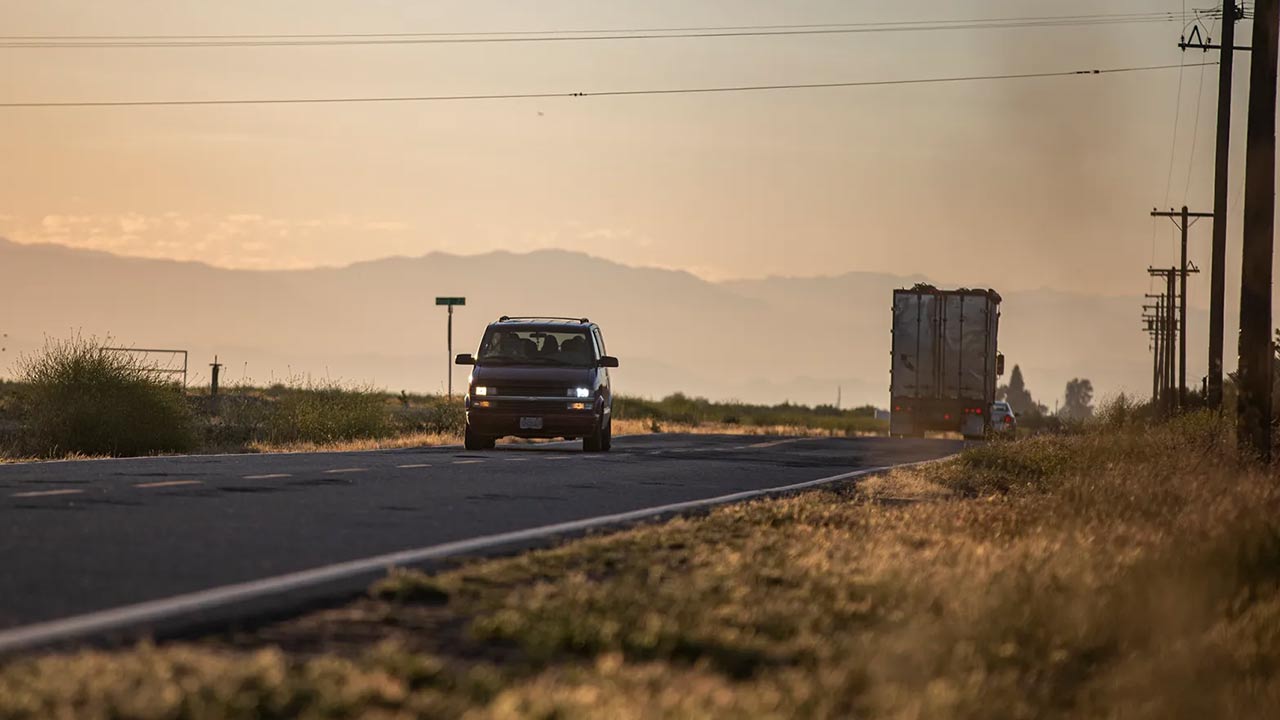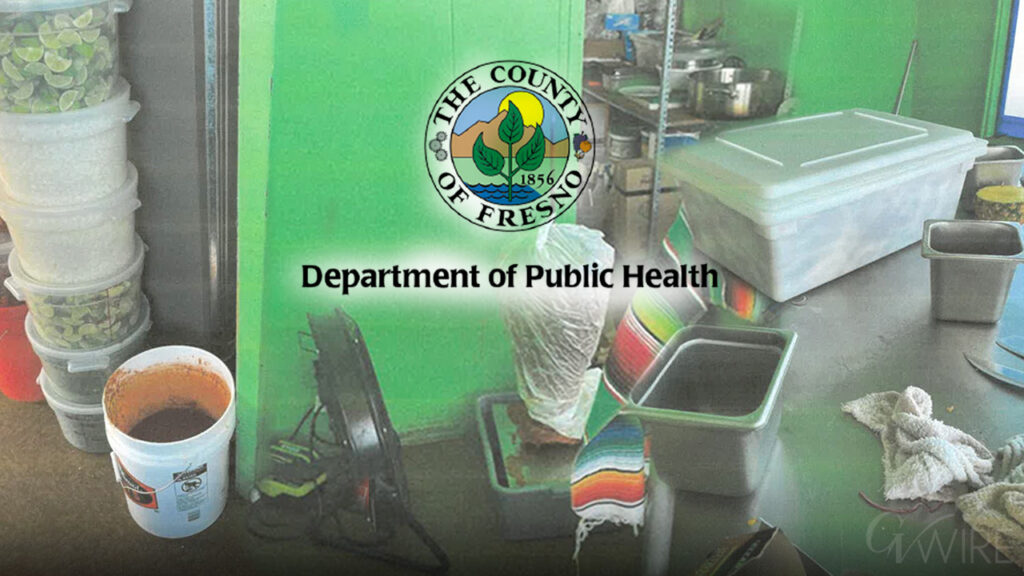After a tragedy 25 years ago, state lawmakers and the California Highway Patrol acted to make farmworkers’ commutes safer. But workers still die in crashes — in vans the law doesn’t cover. (CalMatters/Larry Valenzuela)

- A deadly crash in California's Central Valley claimed the lives of eight farmworkers.
- Despite safety regulations, serious crashes involving farmworkers still occur yearly.
- California's laws don't cover smaller vans, leading to more fatalities in unregulated vehicles.
Share
|
Getting your Trinity Audio player ready...
|
FIREBAUGH — Adorned with Mexican flags, a cluster of crosses in the dirt on the side of a two-lane highway is the only sign of lives lost.

Jeanne Kuang
CalMatters
On any given day, passenger vans whiz by rows of almond trees, carrying farmworkers to the orchards and vineyards that stretch across Fresno and Madera counties. On Feb. 23, a van carrying eight workers collided head-on with a pickup truck, killing all but one of them.
Their bodies have been returned home to Mexico, but the tragedy has left a mark. “I’ve cried a lot for him, as his friend, because, well, it’s a tough blow that we still can’t recover from,” said Oscar Ruiz, whose friend, 57-year-old Roberto Flores, was killed.
It was the deadliest crash in recent memory of a kind grimly familiar to the Central Valley — a van full of farm workers injured or killed on their way to the fields.
And it was the kind of tragedy California has been trying to prevent for decades. In 1999, after 13 workers were killed in a single crash, lawmakers ushered in a slew of regulations to make farmworkers’ commutes safer. For a while, it worked. The number of farmworkers who have died in a vehicle regulated by the state since 2000 is near zero.
Yet 25 years later, a serious crash like the one in February still occurs once nearly every year in California. They just don’t happen in the same kinds of vans.
CalMatters reviewed vehicle crash and labor enforcement data, obtained records from the state and federal government and interviewed workers, advocates, law enforcement, growers, labor contractors and industry experts about transportation for California farmworkers. The unique workforce, half of whom are undocumented immigrants, routinely die in traffic at higher rates than other workers who die on the job.
Related Story: Eight Men, Including Seven Farmworkers, Killed in Madera County Collision
The review found that while the state’s safety enforcement program has reduced fatalities, its laws aren’t as effective as they once were. That’s due to an array of factors:
- The law doesn’t cover smaller vans that carry eight or fewer passengers and that have become more common. These unregulated vans are deadlier: While only a single person has died in a crash involving a state-certified farm labor vehicle since 2000, 54 have been killed since 2012 in uncertified or unregulated ones, according to California Highway Patrol crash data.
- The Highway Patrol’s farm vehicle safety program now certifies less than 10% of the vehicles it did when the law took effect. Its officers spend more time educating workers to use seat belts than inspecting vans and pulling unsafe ones off the road.
- Few employers now directly transport their workers, citing the costs of regulations and insurance. Laborers who can’t afford their own cars either carpool or get driven to work by raiteros who charge a fee — often a coworker, supervisor or someone otherwise affiliated with the employer.
On top of state regulations, federal laws impose strict registration, safety and insurance requirements on anyone transporting farmworkers. In the last five years, the U.S. Department of Labor has fined at least 110 farm employers in California for violations, according to records of closed cases. Ruben Rosalez, Western regional administrator for the department’s Wage and Hour Division, told CalMatters that safety issues are the fault of growers and contractors avoiding responsibility.
In one high-profile case, the department fined both contractor Healthy Harvesting and melon grower Fisher Ranch in Blythe for failing to provide safe transportation in a 2017 crash. A van driven by a foreman for the contractor blew a tire and rolled over, killing one worker and injuring six. The borrowed van was missing a seat belt, had bald tires and two of the wheels weren’t properly secured. The driver had a suspended license. Fisher Ranch paid a $70,000 settlement and agreed to monitor its contractors.
Rosalez’s division and California’s workplace safety agency are both investigating the February crash, which happened as workers traveled from the small town of Kerman to work for a grape grower in Firebaugh. A key question: Who was responsible for arranging the rides?
“The industry has had this underground transportation system for years,” Rosalez said. “Most growers don’t want the responsibility, so they push it down to the foreman to make arrangements.”

How Did the State Try to Prevent Deaths?
The ride to and from the fields is one of the most dangerous parts of the job.
Transportation, which include traffic deaths as well as tractor crashes, make up more than a third of all workers’ on-the-job fatalities. Between 2015 and 2022 in California, 58% of agricultural workers who died on the job were killed in transportation incidents, compared with 47% nationwide. That’s according to federal workplace safety data. (There was no California data in 2020 and 2021.)
In the Central Valley, such tragedies were once a regular part of the harvest.
In the 1990s, labor contractors or raiteros often drove workers to the fields in conditions that advocates likened to human trafficking — ripping the seats out of old vans and replacing them with wooden benches, paint cans or nothing at all, then assigning an unlicensed driver and stuffing in as many workers as possible.
In 1999, a van carrying 15 farmworkers, sitting on wooden benches with no seat belts, slammed into a big rig in the early morning near Five Points in rural Fresno County. Thirteen workers were killed. The driver was unlicensed.
Related Story: 8 Killed, Near 40 Injured in Central Florida as Farmworkers’ Bus Flips
State lawmakers and the Highway Patrol sprung into action. Vehicles taking farmworkers to and from the fields, no matter who arranged them, had to be certified and inspected every 13 months. Seat belts — previously not required for farm labor vehicles — became mandatory for every passenger.
The Highway Patrol created the unit to enforce the new laws, pulling unsafe or overcrowded vans off the road. The program, by all accounts, saved lives.
But the law only covers vans or buses that carry nine or more farmworkers, other than the driver — a threshold chosen because that was the standard farm labor vehicle at the time, said Dean Florez, who authored the law while serving in the state Assembly.
Now, smaller vans like the one in the February crash are much more common. Florez said nine wasn’t “a magic number” that can’t change.
“Things do change, and people find a way around regulations,” he told CalMatters. “Hopefully (the Legislature) will tweak the rule to include a lower number. Anything that can protect workers in any number, that’s the key point.”
In its first year, the Highway Patrol unit inspected thousands of vehicles operated by employers or their contractors, and certified 1,275. Last year, it conducted 73 inspections and certified just 55 vehicles.

Through turnover, the farm vehicle safety unit has dwindled from 10 officers to six, covering the entire Central Valley. They still impound about 30 unsafe vehicles a year. In March, an officer pulled over a van packed with 10 workers despite only having seats for seven passengers. Photos taken at the inspection and provided by the unit show one worker sitting on a bucket; another is behind the back row.
But without the requirement for many labor vans to be certified, officers don’t know who’s responsible. They visit the fields and farm labor contractors instead, reminding workers and employers to use seatbelts.
“It’s more of a community outreach program than an enforcement program,” said Highway Patrol Sgt. Gabriel Perez, who leads the unit. “We do a lot more education today than they did enforcement then.”
When Are Farmworkers Most in Danger?
The crashes match farmworkers’ commutes, occurring mostly in the early morning.
CalMatters’ analysis of statewide vehicle collision data also found that while there are more crashes involving state-certified farm labor vehicles, injuries and deaths overwhelmingly occur in either vans that the driver didn’t get certified, or smaller vans that aren’t covered at all by the law.
Nearly half of those who died weren’t wearing seat belts. That’s what happened in the February accident, which occurred just after 6 a.m. on Avenue 7 in Madera County. Because it carried seven passengers, the van wasn’t required to be inspected or certified by the Highway Patrol. It was registered and had seat belts, the Highway Patrol said, but most of the workers weren’t wearing them.

The workers were headed to Lion Farms, a grape grower and raisin producer. The Highway Patrol said it believes the 78-year-old driver of the pickup truck crossed over the center divider before striking the van. The truck driver was also killed; police have ruled out alcohol or drugs as a contributing factor.
Lion Farms did not return multiple calls seeking comment.
In May 2022, a van carrying 11 farmworkers on their way home veered off the road in Yolo County, killing four of them. A month earlier, a van carrying eight workers failed to stop at a stop sign in Fresno County, collided with another vehicle and rolled over, killing one of them.
The state’s crash data may be an undercount. Not all officers statewide include farm vehicle information when responding to crashes. The data does not include, for example, a crash last October in northern Sonoma County, where a van carrying seven workers ran off the road and hit a tree, before dawn on the way to the Cooley Ranch vineyard near Cloverdale.
They were in the country under the H-2A visa program, which allows farm labor contractors to temporarily bring foreign workers. Jesse Alderete, vice president of the contractor that employed the workers, Premium Employment Services, called the incident a “basic accident” that didn’t involve serious injuries.
While all the workers survived, a Northern Sonoma County Fire incident report obtained by CalMatters showed two had to be airlifted to the hospital. The U.S. Department of Labor is still investigating.
Related Story: After Farmworker’s Death in Fresno Heat, UFW and Sen. Padilla Call for ...
Who’s Responsible for Safety?
Employers say vehicle safety is largely out of their hands because most growers and labor contractors no longer directly provide rides.
Workers now often drive themselves, especially after California began allowing undocumented residents to get driver’s licenses in 2015, and many prefer to carpool, employers said.
But the industry primarily blames state and federal requirements for making it costly to drive workers: vehicle certification by multiple agencies, authorization to transport workers by the Department of Labor, vehicle insurance of at least $100,000 per seat and sometimes commercial drivers’ licenses. Many insurance plans don’t write policies after so many crashes, said Manuel Cunha Jr. of the Nisei Farmers League, which represents both growers and labor contractors. The league, he said, supported the seat belt requirements in 1999.
“Employers today want their workers to come to work safe and they want them to go home safe to their families,” he said. “The transportation of farmworkers today by employers is just about nil, because the regulations — not the safety side, but what you have to go through, and what agencies you have to deal with — it’s not easy.”
The primary exception is the H-2A guest worker program, which requires labor contractors to provide housing, food and transportation. There are more than 40,000 of these workers in California each year, compared to as many as 800,000 year-round and seasonal farmworkers overall. Last month, the federal Department of Labor began requiring vehicles in the program to have seat belts.
The United Farm Workers pushed for that provision.
“Whoever is employing these farmworkers, we think they should be held accountable for keeping them safe,” said Elizabeth Strater, a union spokesperson. “There are workers who are so economically desperate that they’re not going to turn down the transportation options they have. And it’s even more tenuous for workers like H2A workers who are completely dependent on their employer for it.”
About the Author
Jeanne Kuang is an accountability reporter who covers labor, politics and California’s state government. She focuses on how well officials follow through on laws, such as indoor heat protections for workers, a higher minimum wage for fast food employees and a second chance for those convicted of crimes. Her stories also highlight how state policies affect disadvantaged communities, such as low-income renters or immigrant workers.
About CalMatters
CalMatters is a nonprofit, nonpartisan newsroom committed to explaining California policy and politics.


















